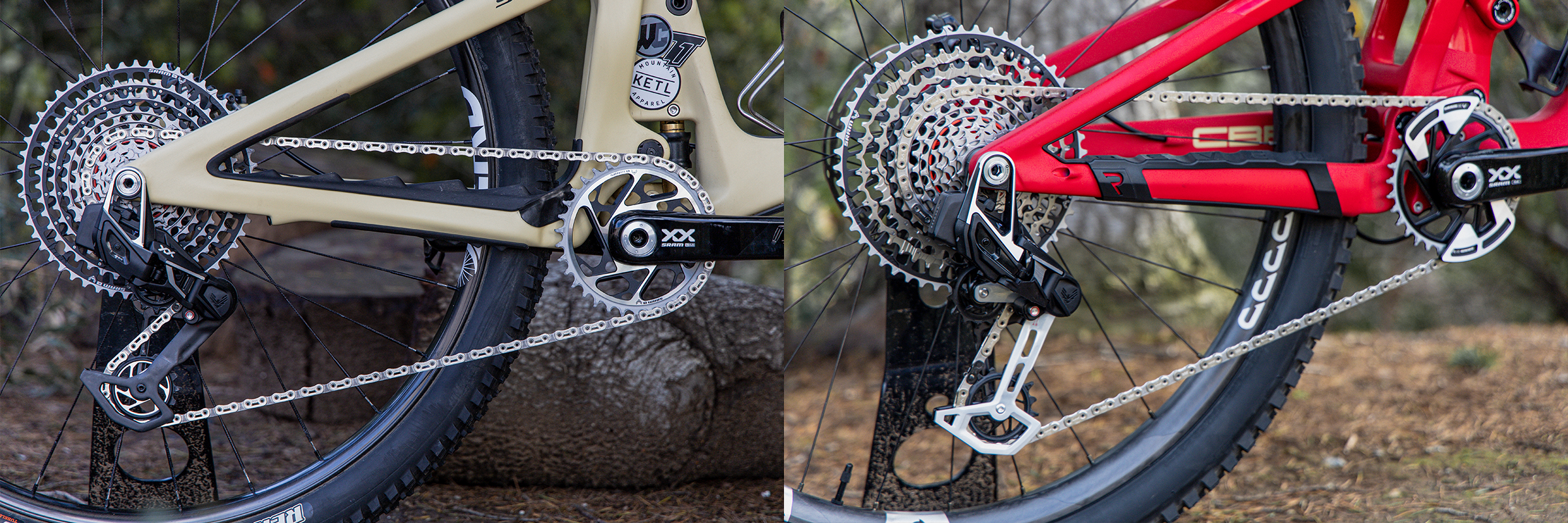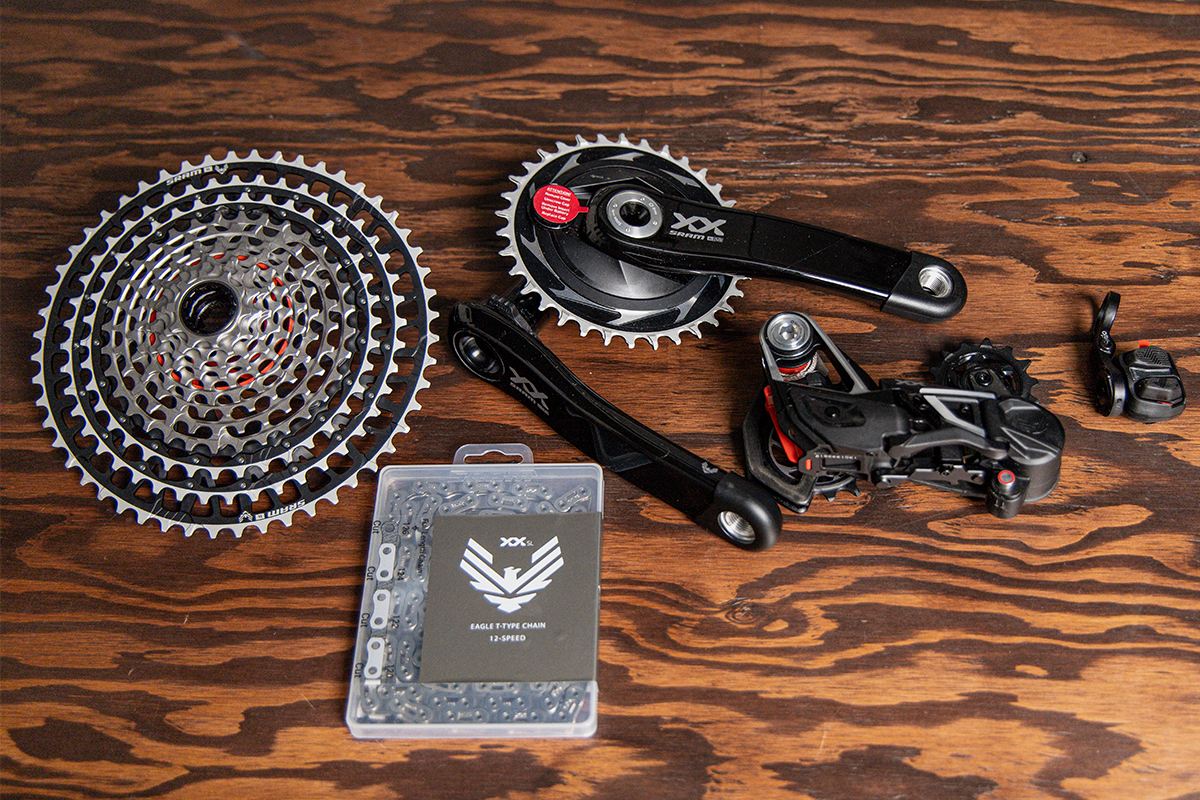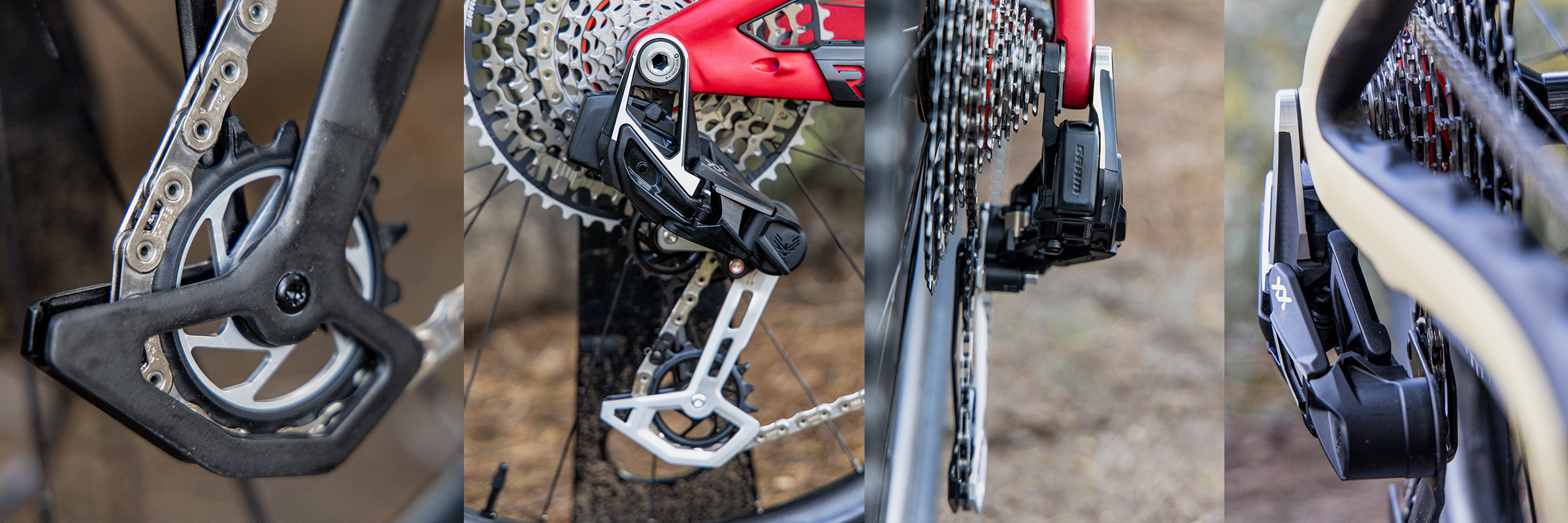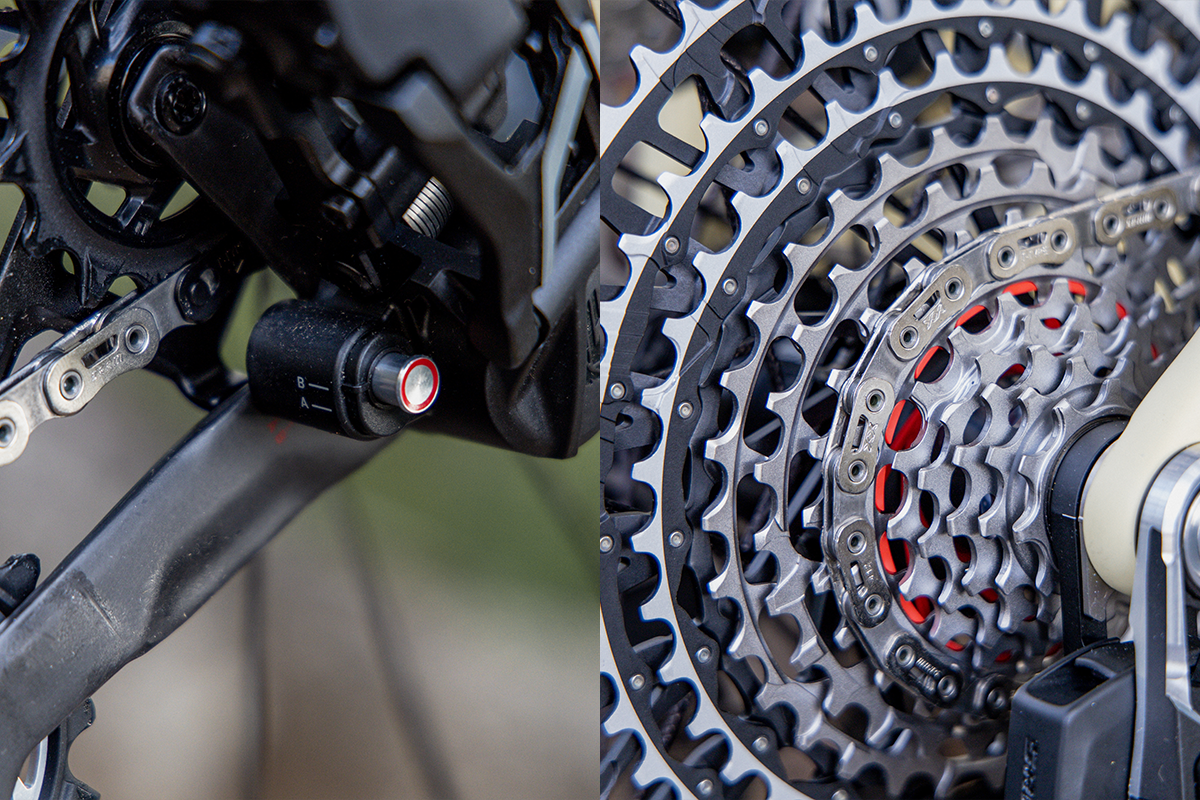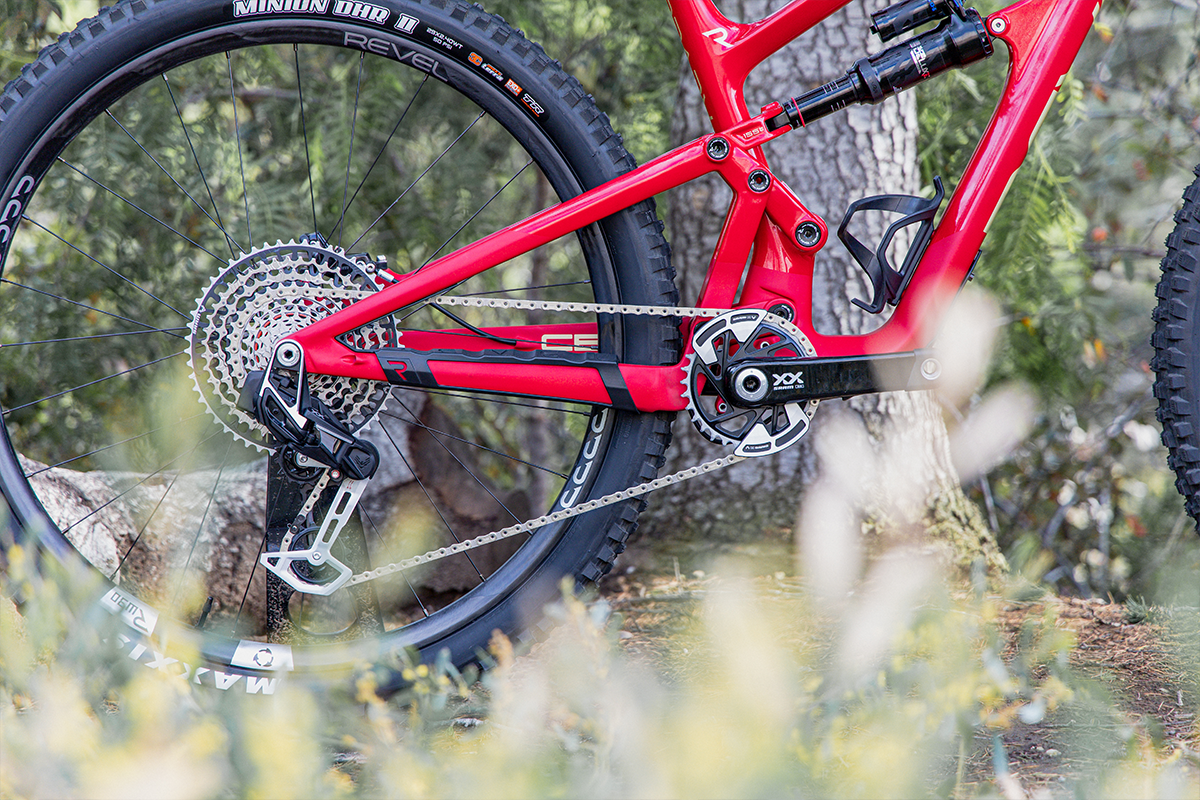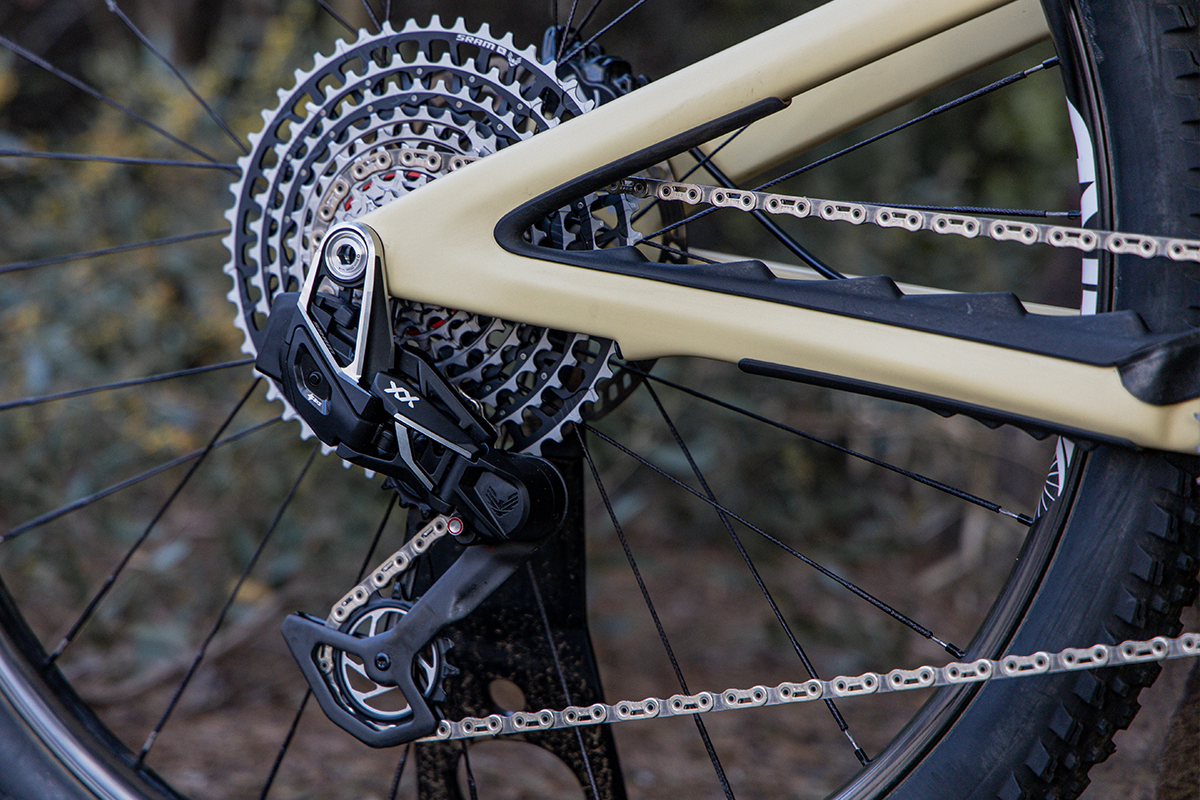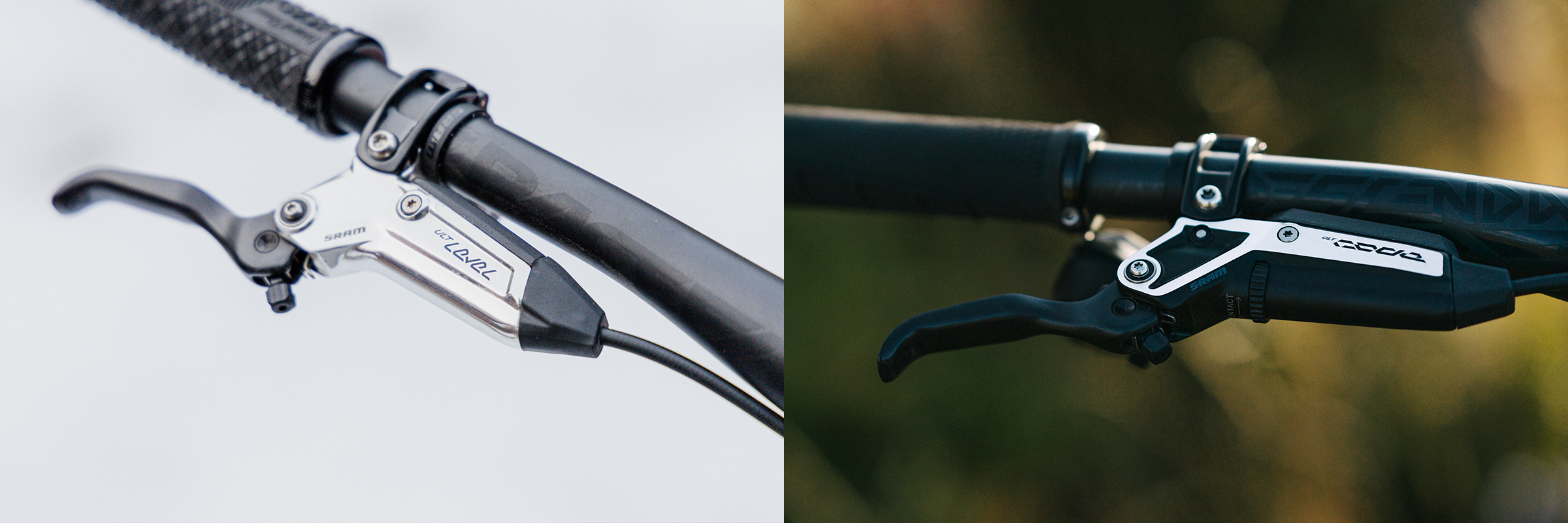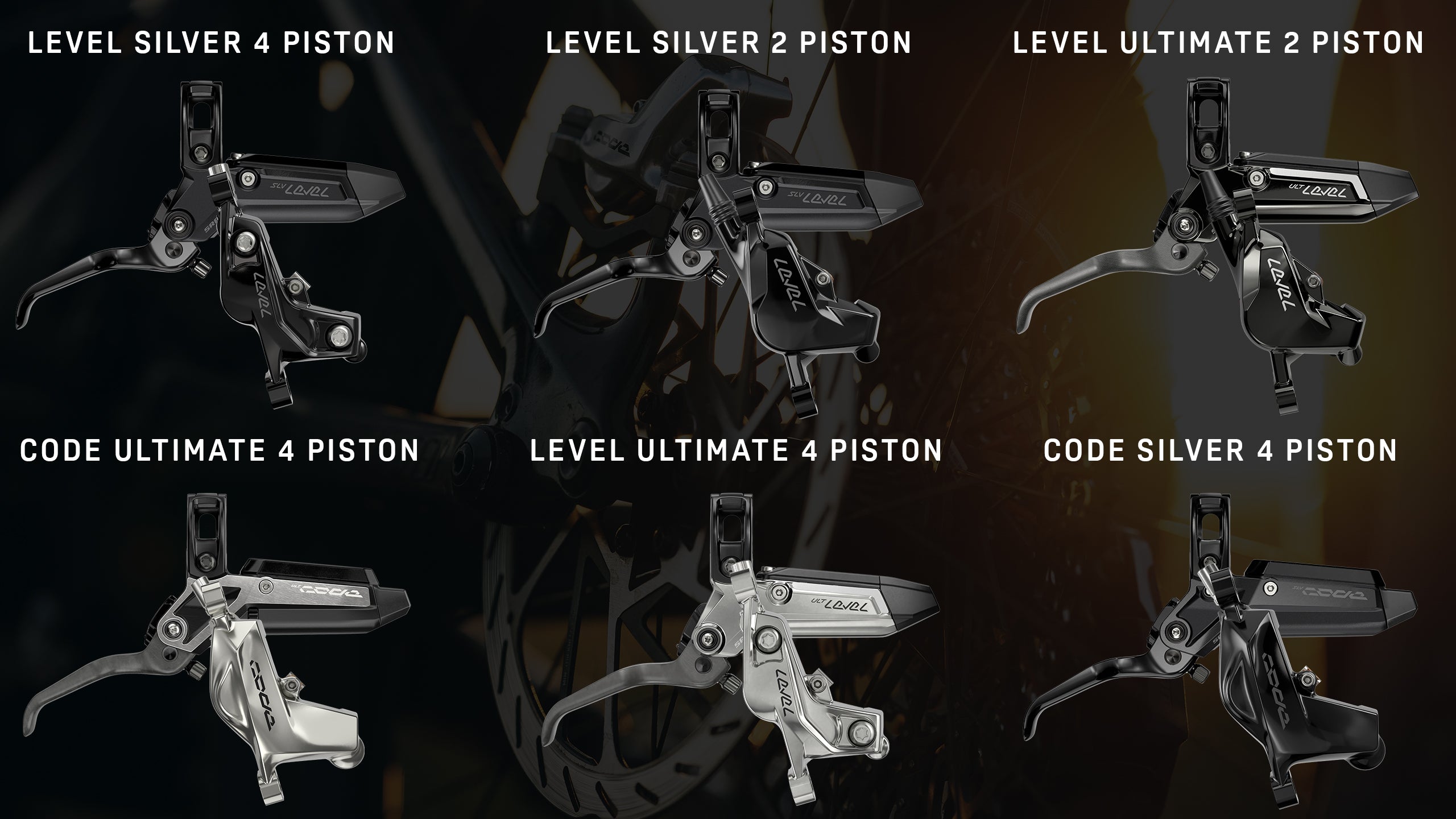- Continue Shopping
- Your Cart is Empty
SRAM Eagle T-Type Transmission & Stealth Brakes Review - Electronic MTB Drivetrain Redefined [Video]
Words by: Liam Woods & Trevor Mejia
How Does SRAM Make Eagle AXS Even Better?
Sram T-type Transmission drivetrain is here. Can you believe that SRAM released its first 12-speed Eagle drivetrain over six years ago? And it's even been four years since SRAM Eagle AXS first came out! Yes, those pandemic years are blurry and time has been oddly fast since 2020. But those two statements above are true, and now SRAM is back to update its Eagle ecosystem once again with the new SRAM Eagle Transmission Drivetrain. A lot has changed but also not so much at the same time. It's still 12-speed, it's still the same wireless AXS shifting that we love, so why the update? Well, a few years ago SRAM started to make the SRAM UDH, a Universal Derailleur Hanger that helped solve the crisis and headache of finding the right derailleur hanger for your bike. It helped consumers, bike shops, and even bike brands as they just needed the design from SRAM and could work that into their bikes. Over the past few years, lots of brands have implemented this on their mountain bikes, including some of the biggest brands in the world. Now, SRAM has taken advantage of all of these bike brands using their UDH design, and the new Eagle Transmission rear derailleur mounts directly to the frame.
I don’t want to pat myself on the back too much here, but years ago when SRAM first released UDH, I told Jeff that after working for 10+ years in shops and having to order very specific hangers, UDH is genius. Then, on top of that, I thought SRAM would eventually have to make a direct mount derailleur. And now the time is here.
SRAM Transmission is offered in full five-piece kits at first, similar to how things were back when Eagle mechanical and Eagle AXS were first released. The different tiers have changed a bit as well. We now have XXSL, XX, and XO, going from the lightest and XC race focused with XXSL, to the all-mountain drivetrain with XX, and last but certainly not lower in performance, the XO which comes with an alloy crank.
What’s New?
Pretty much every bit of Eagle Transmission has been redesigned, but let's start with the star of the show, the rear derailleur. I am also going to abbreviate Eagle Transmission to T-Type as well. First, T-Type rear derailleurs do not have any limit adjustments or b-tension. Yes, SRAM has been able to get rid of those little fussy adjustments and if you noticed, 12-speed drivetrains were and are quite sensitive to the smallest adjustment. Now with the proper installation process, your rear derailleur is adjusted and ready to go. There is a small micro adjustment from the controller and that is all. More than no adjustments, the big deal is the direct mount interface. Not only does the direct mount derailleur eliminate a variable that could be out of whack, but bracing the derailleur on both sides creates a very stiff derailleur body, giving you great shifting performance. Furthermore, lots of the derailleur is now replaceable, including both sides of the lower cage. The XXSL has a carbon cage, whereas XX and XO have alloy cages. The B-knuckle cover is also replaceable. The last two notable features are the overload clutch and the Magic Wheel. The clutch is much more powerful than previous AXS versions so as to keep your chain on and your bike quiet. What about the Magic Wheel? The lower pulley wheel on the derailleur is the Magic Wheel. Basically the pulley wheel is two pieces, and if a stick, bush, mud or any other object gets stuck in that lower pulley wheel, the teeth on the wheel can spin on its own without the full pulley wheel needing to spin. It messes with your head a bit when you first see it, but it's awesome!
Let’s go to the next big change, the shifter pod, or controller pod. Whatever you would like to call it, it's how you shift gears. The first version of the controller was a little hard to get used to, but once you rode it and configured the paddles to do what you wanted, it was all good. Then the second paddle upgrade came out, and for me that was a huge improvement and what I rode last year. Now, the new pod, as SRAM calls it, is even more different. I would say it now has two buttons instead of a paddle to toggle up or down. While it might take another few rides to get used to, I can say after those few rides it's really easy and intuitive to use. I also like the added rubber pads to help keep grip on the buttons while riding. The new pod is quite adjustable as well, being able to spin 360 degrees around, you can really position this new pod however you want it. You can also buy the same pod and flip it to the other side to control your dropper post. Included are two rubber pads you can swap out. Installed are the concave pads which I personally like more, as they help keep my thumb in the pod and a simple up or down shifts my gears. But if you want, you can easily swap out the pads for convex pads, which are a bit more rounded. Lastly, there will be a Matchmaker option aftermarket so you can keep that cockpit clean and it gives you more adjustment than previous Matchmaker mounts.
Crank, chain and cassette all receive updates as well. The cranks for all three tiers have been updated. Not only are they lighter but also receive eight bolt mounting points. So all cranks are now power meter compatible. XXSL gets the lightest crank with a carbon arm that is hollow in the middle. The XX crankset gets carbon arms but with foam filled core for added strength, and in addition the XX crank has a removable bolt on bash guard for both sides. XO crank is now alloy, and yes, it’s the most advanced aluminum crank SRAM has ever made according to themselves. It’s one of the lightest alloy cranks on the market and is also power meter compatible with removable bash guards as well. Cassettes are also redesigned and while they don’t come in fancy colors like the past, the new clean look is very classy. The range is still 10-52t but the progression of the gears have changed. Now you get a 38t, 44t and 52t compared to the previous 36, 42, 52. The jumps are smoother and get you in that sweet spot more often. XXSL is of course the lightest, with a machined steel x-dome range for gears 4-12, but then is on a spider with alloy cogs for gears 1-3. XX is the same but gets stamped steel gears 2 and 3 with an alloy 52t 1st gear. XO follows suit with the XX but has a sleek dark polar finish. Lastly, let’s talk about chains. The flattop is back in, and I’m not talking about your dad’s hair cut. Eagle T-Type flat top chains are also in the three tiers of Eagle Transmission, with XXSL getting a hollow pin and hollow link design, XX gets a hollow pin and is claimed as the strongest SRAM chain ever, and XO doesnt have hollow pins but gets a black finish and is the best chain for e-bike use.
Setup:
I would recommend you watch a really good setup video (SRAM should have them out) as well as read the online manuals. Setup is extremely important with all drivetrains, and the new Eagle Transmission setup is totally different than anything before. One important thing to check and double-check is chain length. SRAM has a chain length guide so you can look at that but also double check how SRAM measures the chain links. Each link is considered one (sometimes an inner and outer link are 1 link). Once you get the chain length, you need to pull off your SRAM UDH and install your rear derailleur. I'll keep this short as I really recommend checking out SRAM’s installation instructions. But from there, you install the derailleur, snug up the 8mm, then install the rear wheel, and tighten the axle up snugly. Then you loosen the derailleur bolt one full turn and same with the axle. From here wrap the chain through the derailleur and place it on the red cog. This is where you should access the SRAM instruction. From my understanding, most bikes will use setup B and place it on the red cog. There are exceptions to this from bike design, depending on suspension style (high pivot, different chain growth bikes, etc). With the chain on the red setup cog, the derailleur with the cage lock B, you pull the rear derailleur tight so the chain now has tension on it and then tighten up the 8mm on the derailleur mount. That right there will set your b-tension and then you are good to tighten up your axle. While shifting through the gears in the stand, you might notice the shifting isn't perfect. That is because it is designed to be shifted under sag. From there you are good to test ride and make some micro adjustments that might be needed and you can do that with the AXS button on the controller pod.
On-Trail Performance:
Of course, the most important part, how does this ride? Can it really get better than before? If I am being honest, I was a little skeptical that the performance would improve rather than have an improved interface and controls. Well, I was proved wrong pretty fast.
I was able to try out both the XXSL and XX groupsets and both have pretty much the same performance as each other. First thing I noticed was how smooth the shifting was. It seems much more elegant than before. It's hard to explain but not quite a clunk but more of a glide into the next gear. Another feature SRAM has been talking about is shifting under load, so I really wanted to test that. After a few sprints in the parking lot it was immediately noticeable. You can literally shift with full power. To me, that actually changes the way you ride, and once you get used to it it's hard to ride a different drivetrain as you shift with power and get those “money shifts”. You know, the ones that cost you money… When you get on the trail, the elegant shifting and shifts under power make a big difference. I found myself shifting in spots I couldn't before, allowing for a smoother ride and better cadence. Easier on the bike, and my body, and translates to less effort overall.
In addition to that, the new clutch system is extremely quiet as advertised, but I was coming off GX AXS which wasn't the most quiet of the AXS systems. Man do I love a quiet bike. The T-Type drivetrain really does give me the least amount of chain slap out of any AXS system I have ridden. Not only is the new override clutch quieter, but I feel confident I could ride this system on the trail bike without an upper chain guide, whereas before I always ran one for peace of mind. So far, no dropped chains.While that wasn't an issue before it's worth noting.
Lastly, the controller pod. The first ride or two required a little adapting, but once I got used to it I really liked it. I said before I wasn’t the biggest fan of the first version of the AXS controller, but I liked the second paddle and used it for years. The new pod feels more tactical and the rubber pads really help keep your thumb in place. For me, the best part is the adjustability of it. I like to rock my shifter under the bar as far as I can. When going downhill and having my thumb grip the bottom of the bar/grip, moving my thumb as little as possible to shift is huge. This new pod allows you to literally position this as far down and at any angle as you want, which is a much bigger deal to me than the new buttons.
Pro/Cons:
Pros:
- Extremely smooth shifting
- Shift under load
- Direct mount derailleur interface
- Overload clutch is very quiet
- Extremely adjustable controller pod
Cons:
- Needs a SRAM UDH frame to work
- AXS only, no mechanical option
- Not backward compatible with older Eagle systems
- Possible future issues with direct mount derailleurs if busted
What's Worldwide's Takeaway?
The new SRAM Eagle Transmission drivetrain really does improve on all previous Eagle drivetrains. Taking the best from the past and genuinely making it better is great to see from SRAM. Utilizing bikes with SRAM UDH, T-Type derailleurs now direct mount to the frame. That gives you improved installation without the need for adjustments, improved shifting performance, and precise control as SRAM knows the tolerances of the frame, derailleur, cassette, and freehub body. The shifter pod is also a great improvement with lots of adjustments and defined buttons. The cassette, chain and crankset are also updated to be lighter, smoother, and faster to work with the Eagle Transmission drivetrains. With three tiers to choose from, XXSL, XX, and X0, there are options for everyone and any type of riding.
SRAM Stealth Brake Collection
New Look, New Finish, Same Great SRAM Brake Power :
Going along with SRAM’s newest Eagle Transmission Drivetrain, they have also come out with an updated and refined version of their proven Code and Level brake systems. These new Stealth brakes feature a new lever body that comes close to and almost parallel to the bar for a clean “cableless” look, especially paired with an AXS or Transmission Drivetrain. These brakes are ready for future cockpit and cable routing integrations that the industry is heading towards.
Both brake systems now come in Ultimate and Silver designations. Ultimate offers a carbon lever blade, bearing pivot, Ti hardware and updated aesthetics for a clean and sleek look . Silver (SLV) is similar to the previous RSC designation with tool-free contact reach, stainless steel hardware, an aluminum lever and a bearing pivot. All models feature a tool-free lever reach adjustment, Swinglink cam for great lever feel as well as continuing to use Matchmaker X clamps to keep the cockpit to a minimum.
To keep noise down, something that most riders are always in search of, SRAM has provided optional stem clips that are to be installed on the two lower stem bolts on conventional stems. These keep the brake lines in place from rattling against the bar and truly keep things quiet and help the aesthetic of no visible cables.
Level has taken over and replaced the previous G2 system and now features a 4-piston caliper alongside the previous 2-piston caliper. Level 4-piston offers a great power to weight ratio for trail and XC riders and uses the same G2 brake pads. Level 2-piston keeps weight down for modern cross country bikes and uses the same brake pad as before. Aesthetics have been updated for a clean and sleek look.
Code remains very similar to the previous generation, adding aesthetic looks and a carbon blade to their Ultimate lineup. We must say that these brakes look amazing and compliment the aesthetic of SRAM’s product line across the board. Code continues to offer the most braking power for Downhill, Enduro and EMTB riding and racing. Code Stealth uses the same brake pads as the previous Code.
Code Stealth
Intended use: Downhill, Enduro, EMTB
Ultimate: Carbon blade, Ti hardware, bearing pivot, updated aesthetics
Silver (SLV): Aluminum blade, Stainless steel hardware, bearing pivot
Level Stealth
Intended use: Trail (4-piston), XC (2-Piston), same lever
Ultimate: Carbon blade, Ti hardware, bearing pivot, updated aesthetics
Silver (SLV): Aluminum blade, stainless steel hardware, bearing pivot
So What’s the Point?
SRAM unveiled these new brakes that are shockingly similar to their previous generation Code and Level systems. They have done away with the G2 brake and it has been replaced with Level 4-piston. These brakes are proven to be reliable and strong so there was really no need to make drastic changes to something that just works. With these brakes being parallel to the handlebars, SRAM is doing its part in future proofing its product. We know that the bike industry is headed towards cables being routed through the headset and these brakes help that design to be cleaner and quieter than before. We imagine that eventually these brakes will go from the lever, straight into the handlebar and into the headset. This is apparent with SRAM’s newest Transmission drivetrain being only available as a wireless system. The attempt at a frictionless cable shifting system with smooth cable curves does not matter to SRAM anymore so might as well keep the cockpit as clean and tidy as possible. This futuristic ecosystem that SRAM created works together seamlessly, quietly, and is ultimately aesthetically pleasing to look upon.
If you are one strange person and would like to read the transcript of the video above, continue reading below!

